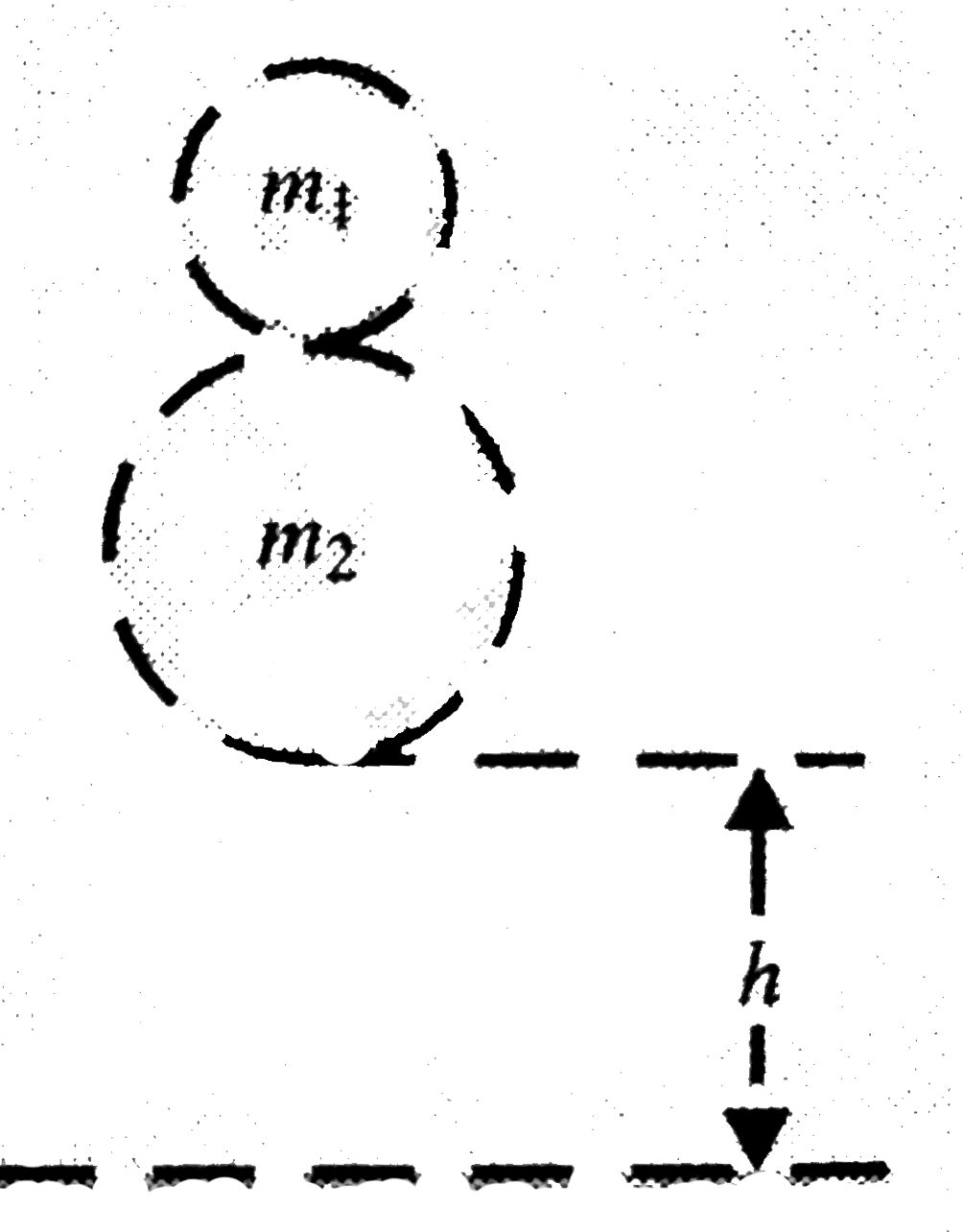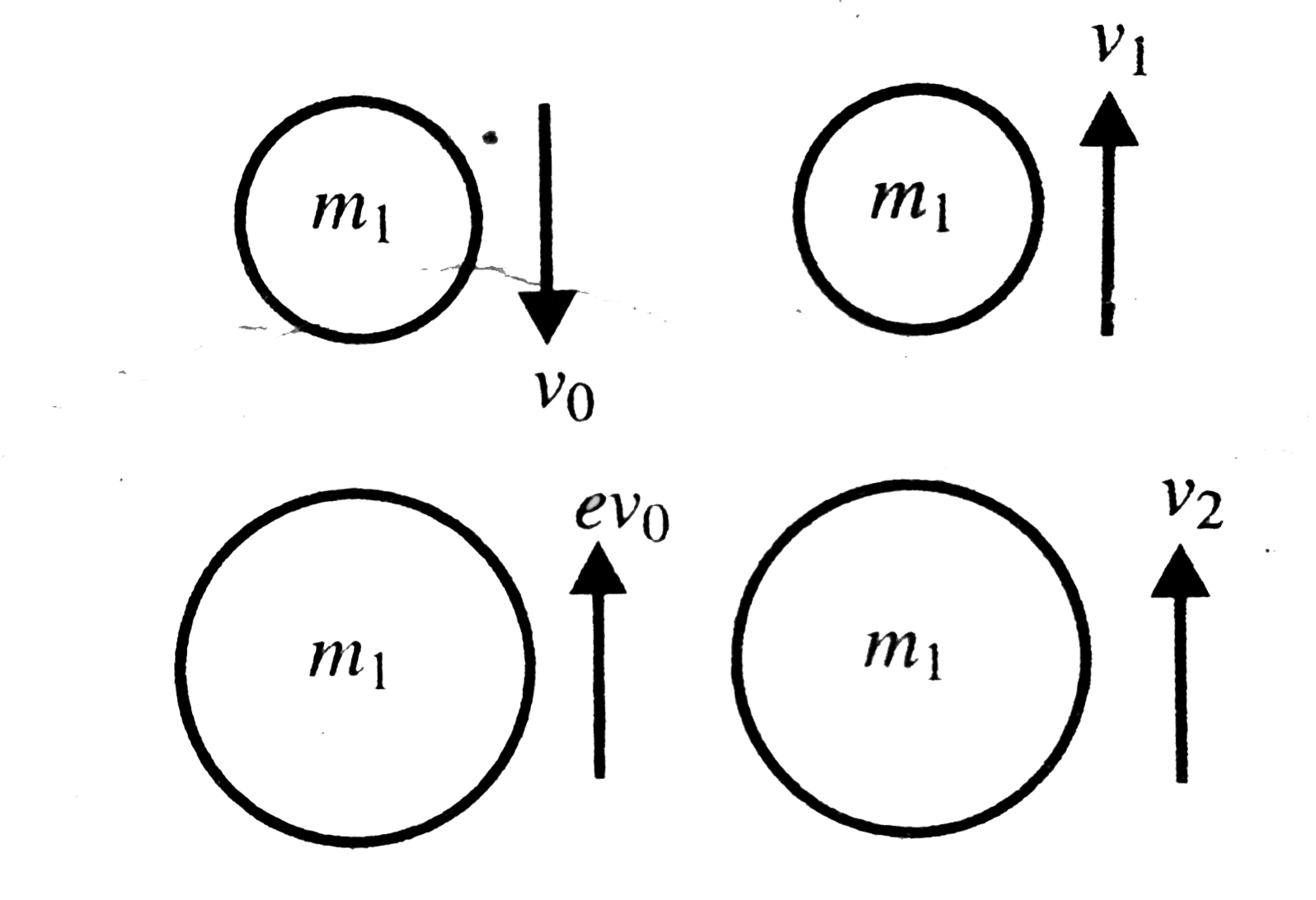Two spherical bodies of mass m1 and m2 fall freely through a distance h. before the body m2 collides with the ground. If the coefficient of restitution of all collisions is e, find the velocity of m1 just after it collides with m2

As the bodies m1 and m2 fall freely through a distance h, m2 collides with ground with velocity v0=√2gh. Hence m2 bounces up with a velocity ev0 just after the collision with the ground.
Hence m2 bounces up with a velocity ev0 just after the collision with the ground. then it collides with the freely falling body m1. Just after the collision, let us assume that v1 and v2 are the velocities of m1 and m2 respectively.
ignoring the impulses due to the weights of the bodies during the period of collision. Let us conserve the momentum of the system (m1+m2).
Conservation of linear momentum
P=−m1v0+m2ev0=m1v1+m2v2.......i

Newton's impact formula −e[u1−u2]=v1−v2
where u1=−v0 and u2=ev0
Then −e[(−v0)−(ev0)]=v1−v2.............ii
Solving eqn i and ii we have
v1=−(m1−em2)m1+m2v0+(1+e)m2m1+m2ev0
Putting m1=m2,e=12 and v0=√2gh we have v1=√gh32↑⏐
⏐
⏐
⏐⏐
Topper's Solved these Questions
- BOOK - CENGAGE PHYSICSCHAPTER - CENTRE OF MASSEXERCISE - Exercise 1.120videos
CENTRE OF MASS
- BOOK - CENGAGE PHYSICSCHAPTER - CENTRE OF MASSEXERCISE - Exercise 1.223videos
CENTRE OF MASS
- BOOK - CENGAGE PHYSICSCHAPTER - CENTRE OF MASSEXERCISE - INTEGER_TYPE1videos
CENTRE OF MASS
- BOOK - CENGAGE PHYSICSCHAPTER - CALORIMETRYEXERCISE - Solved Example13videos
CALORIMETRY
- BOOK - CENGAGE PHYSICSCHAPTER - DIMENSIONS & MEASUREMENTEXERCISE - Integer2videos
DIMENSIONS & MEASUREMENT
Similar Questions
A glass ball collides with an identical ball at rest with v0=2 m/sec. If the coefficient of restitution of collision is e = 0.5, find the velocities of the glass balls just after the collision.
View SolutionA block of mas m moving at a velocity υ collides head on with another block of mass 2m at rest. If the coefficient of restitution is 1/2, find the velocities of te blocks after the collision.
View Solution
Knowledge Check
- Question 1 - Select One
Two bodies of masses m1andm2 fall from heights h1andh2 respectively. The ratio of their velocities when the hit the ground is
A(h1)(h2)B√h1√h2Cm1h1m2h2Dh21h22 - Question 2 - Select One
A ball of mass m moving with velocity v collides head-on which the second ball of mass m at rest. I the coefficient of restitution is e and velocity of first ball after collision is v1 and velocity of second ball after collision is v2 then
Av1=(1−e)u2,v2=(1+e)u2Bv1=(1+e)u2,v2=(1−e)u2Cv1=u2,v2=−u2Dv1=(1+e)u,v2=(1−e)u - Question 3 - Select One
A ball moving with velocity 2 m/s collides head on with another stationary ball of double the mass. If the coefficient of restitution is 0.5, then their velocities (in m/s) after collision will be
A0,1B1,1C1, 0.5D0,2
A body of mass m falls from height h, on the ground, If e is the coefficient of restitution between body and the ground, then the height upto which it rises after ten collisions is
View SolutionA ball moving with velocity 2ms−1 collides head on with another stationary ball of double the mass. If the coefficient of restitution is 0.5, then their velocities (in ms−1) after collision will be
View SolutionA body of mass m falls from height h0 on the ground. If e is the coefficient of restitution between body and the ground, then the height upto which it rises after ten collisions is
View SolutionTwo bodies of masses m1 and m2 are separated by a distance R. The distance of the centre of mass of the bodies from the mass m1 is
View SolutionTwo bodies of masses m1 and m2 are separated by a distance R. The distance of the centre of mass of the bodies from the mass m1 is
View Solution

